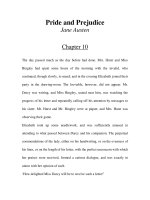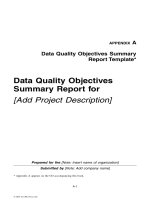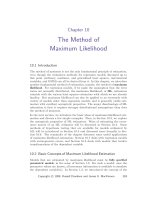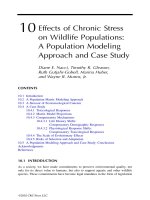Personality classic theories and modern research 6th chapter 10 person situation interactionist aspects of personality
Bạn đang xem bản rút gọn của tài liệu. Xem và tải ngay bản đầy đủ của tài liệu tại đây (246.07 KB, 30 trang )
Personality
Sixth edition
Chapter 10
Person–Situation
Interactionist Aspects of
Personality
Copyright © 2016, 2012, 2009 Pearson Education, Inc. All Rights Reserved
Modules (1 of 2)
Introduction: Person–Situation Interactionist Aspects of Personality
10.1: Interpersonal Psychiatry
10.2: Motivation and Goals
10.3: Modern Interactionist Approaches Begin
10.4: The Power of Situations
Copyright © 2016, 2012, 2009 Pearson Education, Inc. All Rights Reserved
Modules (2 of 2)
10.5: The Importance of Longitudinal Study
10.6: Interactions and Development
Conclusion: Person–Situation Interactionist Aspects of Personality
Copyright © 2016, 2012, 2009 Pearson Education, Inc. All Rights Reserved
Learning Objectives (1 of 2)
10.1: Use the idea of chumship to understand the formation of identity
10.2: Examine the purpose and applicability of psychological screening
10.3: Analyze Walter Mischel's approach that a person's behavior is actually situation
driven
10.4: Examine the effect of situations on behavior
Copyright © 2016, 2012, 2009 Pearson Education, Inc. All Rights Reserved
Learning Objectives (2 of 2)
10.5: Examine the changes in personality that occur over time
10.6: Scrutinize the two basic, independent dimensions of social interactions
Copyright © 2016, 2012, 2009 Pearson Education, Inc. All Rights Reserved
Introduction: Person–Situation Interactionist Aspects of Personality
− Inconsistencies in personality
− Solutions in modern personality psychology
− Situation interactionist approaches to personality
Copyright © 2016, 2012, 2009 Pearson Education, Inc. All Rights Reserved
10.1: Interpersonal Psychiatry
Objective: Use the idea of chumship to understand the formation of identity
Chumship
Metalheads
Copyright © 2016, 2012, 2009 Pearson Education, Inc. All Rights Reserved
10.1.1: Interpersonal Psychiatry Contrasted with Psychoanalytic Theory
− Important neo-analysts
− Interpersonal theory of psychiatry
Copyright © 2016, 2012, 2009 Pearson Education, Inc. All Rights Reserved
10.1.2: Personality as a Pattern of Interpersonal Interactions
− Edward Sapir
− Sullivan’s views on personality
Copyright © 2016, 2012, 2009 Pearson Education, Inc. All Rights Reserved
10.2: Motivation and Goals
Objective: Examine the purpose and applicability of psychological screening
Murray’s methods
Murray’s inspirations
Copyright © 2016, 2012, 2009 Pearson Education, Inc. All Rights Reserved
10.2.1: The Personological System
− Murray’s beliefs
− Environmental press
Copyright © 2016, 2012, 2009 Pearson Education, Inc. All Rights Reserved
10.2.2: Thema
− Overview
− Validity of TAT
Copyright © 2016, 2012, 2009 Pearson Education, Inc. All Rights Reserved
10.2.3: The Narrative Approach:
− Overview
− Importance of internal inclinations
Copyright © 2016, 2012, 2009 Pearson Education, Inc. All Rights Reserved
10.3: Modern Interactionist Approaches Begin
Objective: Analyze Walter Mischel's approach that a person's behavior is actually situation driven
Mischel’s early life
Mischel’s work
Copyright © 2016, 2012, 2009 Pearson Education, Inc. All Rights Reserved
10.3.1: Mischel’s Critique
− Mischel’s arguments
− Correlation coefficient r
Copyright © 2016, 2012, 2009 Pearson Education, Inc. All Rights Reserved
10.3.2: Mischel’s Theory
− Delay of gratification
− Personality variables
Copyright © 2016, 2012, 2009 Pearson Education, Inc. All Rights Reserved
10.3.3: Validity of Traits
− Attribution theories
− Process of better inference of personality
Copyright © 2016, 2012, 2009 Pearson Education, Inc. All Rights Reserved
10.4: The Power of Situations
Objective: Examine the effect of situations on behavior
Personality a weak predictor of behavior
College students of the 1960s
Copyright © 2016, 2012, 2009 Pearson Education, Inc. All Rights Reserved
10.4.1: Trait Relevance and the “Personality” of Situations
− Differing factors between American families 60 years apart
− Different generations
Copyright © 2016, 2012, 2009 Pearson Education, Inc. All Rights Reserved
10.4.2: Consistency Averaged across Situations
− Issues regarding personality tests
− Approaches to Big Five dimensions
Copyright © 2016, 2012, 2009 Pearson Education, Inc. All Rights Reserved
10.4.3: Mirror Neurons
− Overview
− Outcomes
Copyright © 2016, 2012, 2009 Pearson Education, Inc. All Rights Reserved
10.4.4: Personal versus Social Situations
− Field dependence versus field independence
− Qualities in social situations
Copyright © 2016, 2012, 2009 Pearson Education, Inc. All Rights Reserved
10.4.5: Seeking and Creating Situations
− Characteristics of anxious people
Copyright © 2016, 2012, 2009 Pearson Education, Inc. All Rights Reserved
10.5: The Importance of Longitudinal Study
Objective: Examine the changes in personality that occur over time
Effective way to study personality
Characteristics of longitudinal study
Copyright © 2016, 2012, 2009 Pearson Education, Inc. All Rights Reserved
10.5.1: The Life-Course Approach
− Overview
− Process of expanding the concept of life course
Copyright © 2016, 2012, 2009 Pearson Education, Inc. All Rights Reserved









